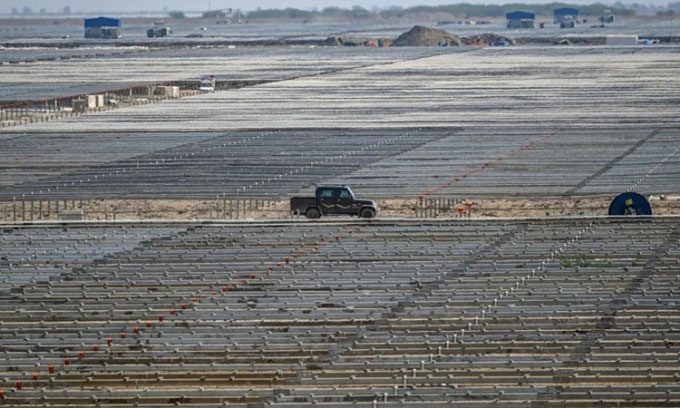An Indian billionaire is building the largest power plant in the world, covering an area five times that of Paris and visible from space, to meet the electricity needs of 16 million households.
The new solar and wind power project will transform the salt desert lands in western India into one of the planet’s most important sources of clean energy, according to CNN. Sagar Adani is the CEO of Adani Green Energy Limited (AGEL), a clean energy company. He is the nephew of Gautam Adani, the second-richest person in Asia, with a net worth of $100 billion from the Adani Group, India’s largest coal importer. Established in 1988, the group operates in various sectors, including ports, thermal power plants, cement, and media.

Khavda Renewable Energy Park under construction in Gujarat state. (Photo: Punit Paranjpe/AFP).
AGEL, a subsidiary of the Adani Group, is constructing a solar and wind power plant in Gujarat, western India, at an estimated cost of around $20 billion. This will be the largest renewable energy park in the world when completed in five years, producing enough clean electricity to supply 16 million households in India.
The success of the Khavda Renewable Energy Park is crucial for India’s efforts to reduce pollution and meet its climate goals, while also addressing the soaring electricity demand of the world’s most populous nation and fastest-growing major economy. Currently, coal accounts for 70% of India’s electricity production. Located just 19 km from the India-Pakistan border, the park will cover an area of over 518 km2 and will be the largest power plant on the planet, according to AGEL.
The clean energy project from the Adani Group comes at a time when India has set several ambitious climate targets. Prime Minister Narendra Modi has promised that renewable sources like wind and solar power will meet 50% of electricity demand by the end of this decade. In 2021, Modi announced that India aims to achieve net-zero emissions by 2070, two decades later than developed economies. The government is targeting a generation capacity of 500 gigawatts (GW) of electricity from non-fossil fuels by 2030. AGEL, the largest renewable energy company in the country, will contribute at least 9% of that electricity, with nearly 30 GW produced from the Khavda park in Gujarat.
India is the third-largest electricity consumer in the world, although per capita electricity use and emissions are less than half the global average, according to data from the International Energy Agency (IEA) in Paris. This could change rapidly. With rising incomes, energy demand has doubled since 2000, with 80% of electricity coming from coal, oil, and biomass. In the next three decades, India’s expanding economy is expected to see the fastest growth in electricity demand compared to any other country.
India will experience annual economic growth of at least 6% in the coming years and could become the third-largest economy on the planet by the end of the decade. As it develops and modernizes, the urban population will surge, leading to increased construction of homes, offices, and various other buildings.
The demand for electricity in India will surge in the near future due to various factors, from improved living standards to climate change. Due to climate change, dangerous heatwaves are spreading across India, driving up the demand for air conditioning. By 2050, total demand for residential air conditioning in India will exceed the total electricity consumption of Africa today. Consequently, India cannot rely on fossil fuels to meet the rising demand without impacting efforts to address the climate crisis.


















































